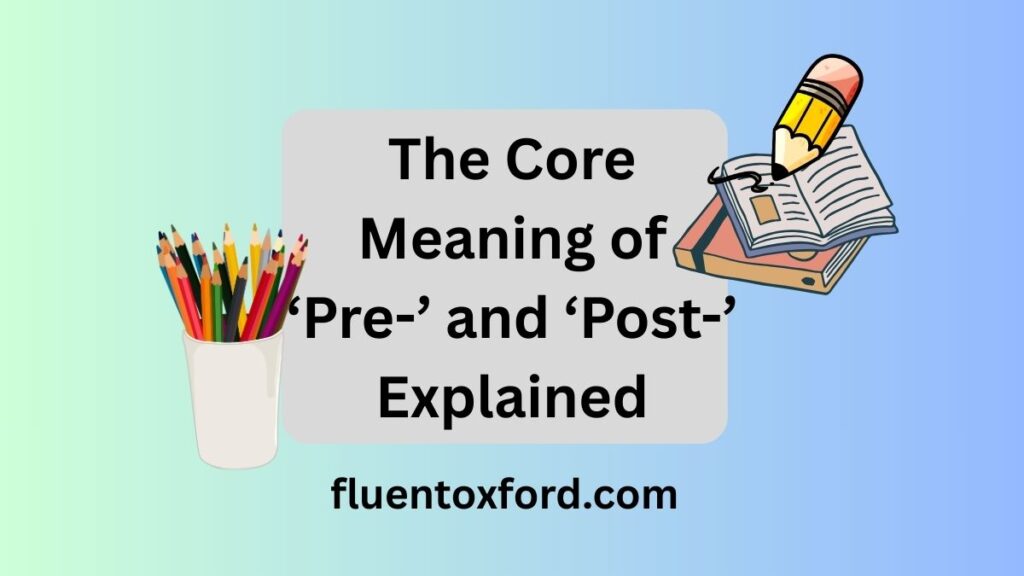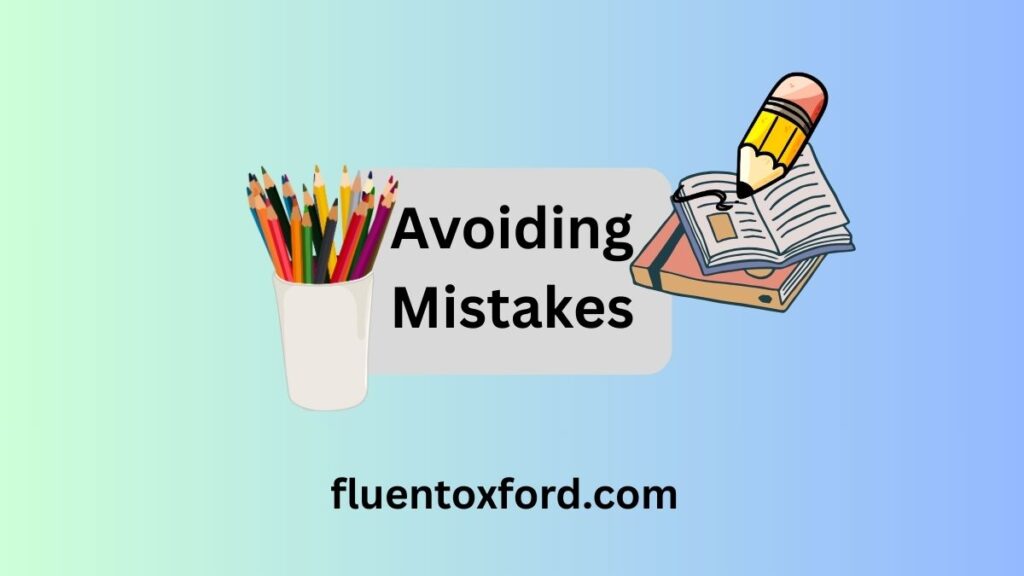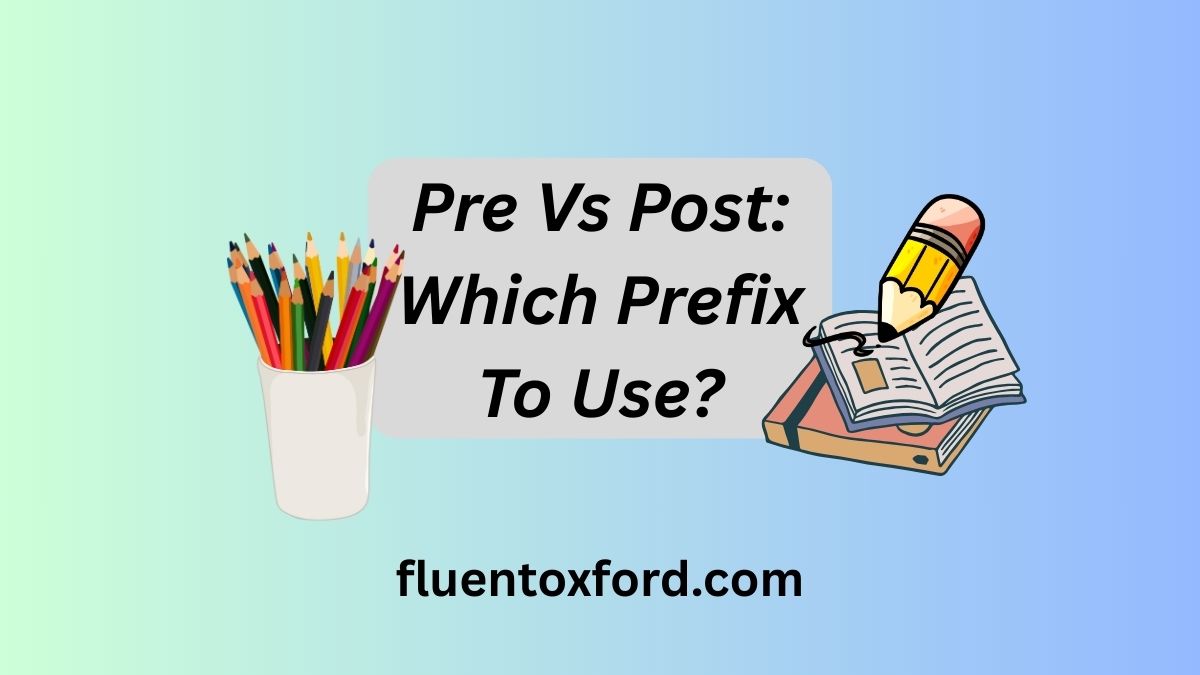“Pre vs Post: Which Prefix to Use?” refers to the decision-making process of selecting the correct prefix—pre- or post-—when forming words in the English language. These prefixes are used to indicate the timing of actions or events in relation to something else. Pre- typically refers to something occurring before a certain event or time, while post- indicates something happening after that point. Understanding how and when to use these prefixes correctly is essential in conveying precise meanings in both spoken and written communication.
Imagine a world where we mix up our words—pre-arranged and post-event might sound similar, but their meanings could be worlds apart. The confusion between pre- and post- can lead to misunderstandings, making it crucial to understand their proper usage. Even small errors can change the context of a sentence entirely, creating miscommunication that could be easily avoided.
The correct use of pre- and post- not only enhances clarity but also improves the flow of language. Whether discussing timelines, plans, or events, knowing when to use these prefixes allows for more accurate and effective communication. By mastering these prefixes, one can add depth and precision to their writing and speech, making them more impactful and professional.
What Are Prefixes and Why ‘Pre’ and ‘Post’ Confuse So Many?
Prefixes are small word elements added to the beginning of a root word to alter its meaning. The English language, rich in Latin influences, has hundreds of them. But understanding prefixes like pre- and post- is crucial because of their widespread usage in multiple contexts: academic, scientific, everyday speech, and formal writing.
Why the Confusion?
- They look similar (just three to four letters)
- They relate to time or sequence
- They can dramatically change the meaning of a word
- They’re used in both technical jargon and casual conversation
Pre and post are two sides of the same coin. The only difference? One looks forward, the other looks back. Think of them as your linguistic time travel signals.
The Core Meaning of ‘Pre-’ and ‘Post-’ Explained

To make sense of the prefixes, let’s travel back in time—literally.
Pre-: Before the Event
Derived from Latin prae, pre- means before. It signals that something occurs ahead of a particular event, time, or state. It’s rooted in anticipation, preparation, or an early stage.
- Example: Pre-order → to order something before it’s available
- Example: Prehistoric → relating to a time before written history
This prefix is often tied to event anticipation, forecasting, or planning.
Post-: After the Event
On the flip side, post- comes from Latin post, meaning after. It indicates something happening later in time, sequence, or condition.
- Example: Postgraduate → relating to studies after earning a degre
- Example: Postwar → occurring after a war
While pre- points to what comes first, post- is all about aftermath and results. The opposite meanings are clear, but the subtlety lies in the usage.
How ‘Pre’ and ‘Post’ Shape Time and Sequence
Both prefixes anchor words to a temporal reference—a specific spot on a timeline. Here’s a visual breakdown:
Timeline: A Quick Visual Guide
|—- Pre-Phase —-|—– [Event] —–|—– Post-Phase —–|
Pre- represents preparation or conditions leading up to the event.
Post- signifies consequences, changes, or analysis that happen after.
These prefixes help mark a logical flow:
- Prelaunch activities: marketing, testing, design
- Launch: the main event
- Postlaunch phase: feedback, analysis, support
Pre vs Post: How to Choose the Right Prefix
Mastering this choice requires attention to context, not just memorization.
Context-Based Decisions
Ask yourself: Does the action take place before or after something specific?
| Situation | Prefix to Use | Example Word | Meaning |
| Before a test | Pre- | Pretest | An assessment given beforehand |
| After a surgery | Post- | Postoperative | Care provided after surgery |
| Before graduation | Pre- | Pregrad | Events or actions prior to graduating |
| After analysis | Post- | Post-analysis | Review or steps following analysis |
Functionality Check
- If the word implies forecasting, planning, or build-up, go with pre-.
- If it hints at results, reflections, or aftermath, choose post-.
Pro Tip: Think like a movie director. Everything before filming is pre-production, everything after is post-production.
Pre- and Post- in Different Disciplines
Let’s break it down by field. Prefixes don’t operate in a vacuum—they adapt based on context and industry.
Medical Terminology
| Prefix | Word | Meaning |
| Pre- | Preoperative | Events or instructions before surgery |
| Post- | Postoperative | Recovery, care, or monitoring after surgery |
In healthcare, precision matters. Mixing up pre-chemotherapy and post-chemotherapy could literally change outcomes.
Business and Finance
- Pre-tax income: Profit before taxes are deducted
- Post-tax return: Earnings left after tax
Technology and Science
- Pre-launch testing: Running diagnostics before a product or satellite is launched
- Post-launch analytics: Measuring success and gathering data after the release
This is a crucial writing tip: always double-check that your prefix aligns with the event’s timing.
Commonly Used Pre and Post Words (with Definitions)
Let’s get practical with frequently used words and what they actually mean.
Pre- Words and Their Definitions
| Word | Meaning |
| Precondition | A condition that must be met in advance |
| Pretrial | Legal procedures that happen before a trial |
| Preschool | Educational setting before kindergarten |
| Prepay | To pay for something ahead of receiving it |
| Preflight | Checks done before a flight takes off |
Post- Words and Their Definitions
| Word | Meaning |
| Postgraduate | Academic studies done after a bachelor’s degree |
| Postmortem | Examination after death |
| Postnatal | Pertaining to the period after childbirth |
| Postseason | Games played after the regular sports season |
| Postscript (P.S.) | An addition to a letter after it ends |
These examples highlight not just grammar rules but practical, real-world applications.
Avoiding Mistakes: When the Prefix Changes the Meaning

Sometimes a prefix can subtly (or not-so-subtly) shift the meaning of a word.
Watch Out For These Confusions
- Prescription (pre-): a doctor’s written instructions
- Postscript (post-): an added note after a letter ends
Misusing them can blur your intent and damage credibility—especially in technical writing or legal documents.
Tips for Mastering Pre and Post in Writing
Here are quick, practical writing tips to strengthen your prefix usage:
- Use mnemonics: Pre = Prepare, Post = Past
- Re-read in context: Does your prefix make logical sense with the event?
- Practice in the wild: Highlight pre- and post- words while reading newspapers or academic journals
- Create flashcards with context-based examples for study
“Good writing is clear thinking made visible.” – Bill Wheeler
Get your prefixes right, and your clarity jumps instantly.
Quick Reference Table: Pre vs Post Prefixes
| Prefix | Core Meaning | Used For | Example |
| Pre- | Before | Planning, early stages, forecasting | Pre-event checklist |
| Post- | After | Results, consequences, follow-up | Post-crisis review |
A Historical Journey Through Pre and Post
Both prefixes come from Latin and have been carried forward through centuries of English evolution. The common ancestor for both is Latin’s love of placing words in clear temporal order. They’ve survived through centuries of morphological analysis to become core language devices in modern communication.
- Pre- found early usage in Latin military documents for planning battles
- Post- appeared in Roman records describing aftermaths of political events
This historical journey adds richness to everyday words we now take for granted.
Modern Usage Trends: Pre vs Post in Digital Communication
As language evolves with technology, so does the application of prefixes like pre- and post-. In today’s fast-paced digital world, these prefixes help structure communication timelines clearly.
Examples in Tech and Digital Media:
- Pre-recorded webinar – Content made in advance, offering scheduling flexibility.
- Post-update feedback – Comments or bug reports submitted after a software update.
- Pre-event registration – Online forms and early access sign-ups.
- Post-viral strategy – Marketing efforts that capitalize on momentum after viral success.
In tech and marketing, pre- sets the stage, and post- optimizes results. This clarity is crucial in UX writing, email marketing, and product development documentation.
💡 Trend Insight (2025): According to Grammarly and digital writing tools, “post-” usage in digital content has grown by 23% over the past two years—especially in SEO and analytics contexts.
How Prefixes Affect SEO and Content Strategy
In content writing and digital strategy, prefix usage isn’t just a grammar issue—it directly impacts search engine optimization (SEO).
Why It Matters:
- Keywords like post-pandemic, pre-launch checklist, or post-sale support are specific, time-stamped, and high in user intent.
- Search engines recognize these terms as part of lexical semantics, helping match user queries with relevant content.
- Using pre- and post- accurately boosts clarity, which improves bounce rates and engagement.
| SEO Term | Search Intent |
| Pre-launch strategy | Users preparing to introduce something |
| Post-event report | Users looking for summaries or evaluations |
| Pre-trip checklist | Travelers seeking info before departure |
| Post-sale service | Consumers needing support after buying |
Using these prefixes thoughtfully can position your content for better visibility, higher relevance, and improved click-through rates.
SEO Tip: Combine prefix usage with long-tail keywords for higher precision and stronger on-page optimization.
Case Studies: How Prefixes Influence Meaning

Case Study 1: Marketing Campaigns
- Pre-launch campaign: Teasers, countdowns, influencer marketing
- Post-launch campaign: Retargeting ads, surveys, product support
Using the wrong term here could send the wrong team working on the wrong timeline.
Case Study 2: Education Sector
- Preschool: Introduces toddlers to structured learning
- Postgraduate: Advanced education typically focused on research
Each has a unique audience, time frame, and purpose. Swapping them doesn’t just sound wrong—it is wrong.
Conclusion
In conclusion, understanding Pre vs Post: Which Prefix to Use? is important for clear and accurate communication. The right prefix can change the meaning of a word and make your message more precise. By knowing when to use pre- or post-, you can avoid confusion and improve your writing.
Mastering Pre vs Post: Which Prefix to Use? helps you express time-related ideas more clearly. Whether you’re talking about something happening before or after an event, choosing the right prefix makes your message easier to understand. With practice, using pre- and post- correctly will become second nature, making your communication stronger and more effective.
FAQs:
1. What’s the difference between pre- and post-?
Pre- means “before,” while post- means “after.” They indicate timing in relation to a specific event or condition.
2. Can pre- and post- be used in the same sentence?
Yes! For example, “The pre-launch meeting was followed by a post-launch review.”
3. How do I remember when to use pre- vs post-?
Think of pre- as the phase before something happens, and post- as the phase that comes after.
4. Are there any exceptions to the pre- and post- rule?
In some cases, the prefixes might not follow traditional time references, like postscript (an addition after a letter) or prejudiced (having an opinion before knowing facts).
5. Can I use pre- and post- for non-time-related concepts?
Yes, both prefixes can refer to stages or phases, not just time—like precondition (a necessary condition before something) or postmortem (an analysis after an event).

As an admin at Fluent Oxford, Maida Queen is the driving force behind our vibrant learning community. With a deep passion for English language education, she ensures that our platform remains a dynamic, engaging, and supportive space for learners worldwide.
Maida expertly manages content, assists users with their grammar and fluency queries, and fosters an interactive environment where learning feels effortless and enjoyable. Whether you need guidance, motivation, or just a friendly face in the Fluent Oxford community, Maida is always there to help you reach your English language goals.








